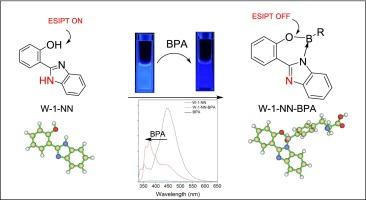针对硼中子俘获疗法(BNCT)中潜在应用的双酚 A(BPA)荧光探针的合成与机理研究
IF 4.3
2区 化学
Q1 SPECTROSCOPY
Spectrochimica Acta Part A: Molecular and Biomolecular Spectroscopy
Pub Date : 2024-10-22
DOI:10.1016/j.saa.2024.125318
引用次数: 0
摘要
硼酸类似物在现代有机化学和药物开发中至关重要,是具有重要治疗用途的多功能试剂和中间体。随着最近用于硼中子俘获疗法(BNCT)的药物 4-硼-L-苯丙氨酸(L-BPA)的开发,这一领域越来越受到关注。荧光探针技术为药物的体外和体内成像提供了一个重要途径,可为疾病诊断和药物开发提供高灵敏度和高时空分辨率。本文设计并研究了三种荧光探针--W-1-NN、W-2-NS 和 W-3-NO,用于感知 4-硼-L-苯丙氨酸(L-BPA)。其中,只有 W-1-NN 能与 L-BPA 发生反应,从而产生光谱蓝移变化。该探针可 "按比例 "特异性地检测各种金属中的 L-双酚 A,检测限(LOD)为 7.11 μM。机理研究表明,加入 L-BPA 会破坏 W-1-NN 在质子溶液中固有的 ESIPT 机理,从而在 372 纳米波长处出现新的峰值。此外,理论计算研究还表明,W-1-NN 与 L-BPA 的络合会引发共振结构的变化,从而导致能隙增大,引起光谱蓝移。此外,W-1-NN 已成功应用于人体尿液中双酚 A 的检测。因此,以 N/O 为目标并引入 N 原子的模板探针可以特异性地检测 L-双酚 A。该模板探针为检测 L-BPA 奠定了基础,并为将来实现模板探针与不同的荧光团连接,使其发射长波长以达到近红外目标提供了极大的可能性。本文章由计算机程序翻译,如有差异,请以英文原文为准。

Synthesis and mechanistic investigation of BPA fluorescent probes targeting BPA for potential application in Boron Neutron Capture Therapy (BNCT)
Boronic acid analogs are crucial in modern organic chemistry and drug development, serving as versatile reagents and intermediates with significant therapeutic applications. This area has gained increased interest with the recent development of the drug 4-boron-L-phenylalanine (L-BPA) for boron neutron capture therapy (BNCT). Fluorescent probe technology offers an essential pathway for imaging drugs in vitro and in vivo, providing high sensitivity with great spatial and temporal resolution for both disease diagnosis and drug development. In this paper, we designed and investigated three fluorescent probes—W-1-NN, W-2-NS and W-3-NO—for sensing 4-boron-L-phenylalanine (L-BPA). Among these, only W-1-NN reacts with L-BPA, resulting in a spectral blue-shift change. This probe can “ratiometrically” and specifically detect L-BPA among various metals, with a limit of detection (LOD) of 7.11 μM. Mechanistic studies revealed that the addition of L-BPA disrupts the inherent ESIPT mechanism of W-1-NN in protonic solutions, resulting in the appearance of a new peak at 372 nm. Additionally, theoretical computational studies have also demonstrated that the complexation of W-1-NN with L-BPA triggers a change in the resonance structure, resulting in a larger energy gap and causing a blue shift in the spectrum. Furthermore, W-1-NN has been successfully applied to the detection of L-BPA in human urine. Therefore, the template probe with N/O as the target and the introduction of N atoms can specifically detect L-BPA. This template probe lays the foundation for the detection of L-BPA, and provides great possibilities for the future realization of the template probe to be connected with different fluorophores to make it emit at long wavelengths to reach the target of the near-infrared.
求助全文
通过发布文献求助,成功后即可免费获取论文全文。
去求助
来源期刊
CiteScore
8.40
自引率
11.40%
发文量
1364
审稿时长
40 days
期刊介绍:
Spectrochimica Acta, Part A: Molecular and Biomolecular Spectroscopy (SAA) is an interdisciplinary journal which spans from basic to applied aspects of optical spectroscopy in chemistry, medicine, biology, and materials science.
The journal publishes original scientific papers that feature high-quality spectroscopic data and analysis. From the broad range of optical spectroscopies, the emphasis is on electronic, vibrational or rotational spectra of molecules, rather than on spectroscopy based on magnetic moments.
Criteria for publication in SAA are novelty, uniqueness, and outstanding quality. Routine applications of spectroscopic techniques and computational methods are not appropriate.
Topics of particular interest of Spectrochimica Acta Part A include, but are not limited to:
Spectroscopy and dynamics of bioanalytical, biomedical, environmental, and atmospheric sciences,
Novel experimental techniques or instrumentation for molecular spectroscopy,
Novel theoretical and computational methods,
Novel applications in photochemistry and photobiology,
Novel interpretational approaches as well as advances in data analysis based on electronic or vibrational spectroscopy.

 求助内容:
求助内容: 应助结果提醒方式:
应助结果提醒方式:


